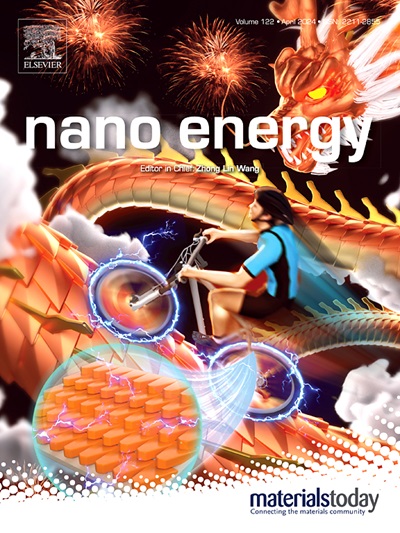A strategy for enhancing interfacial thermal transport in Ga2O3-diamond composite structure by introducing an AlN interlayer
IF 16.8
1区 材料科学
Q1 CHEMISTRY, PHYSICAL
引用次数: 0
Abstract
Heat dissipation issues have emerged in power devices due to miniaturization and high power density, particularly for materials like low-thermal-conductivity gallium oxide (Ga2O3). Increasing interfacial heat transfer has been identified as a critical strategy for tackling these issues. This study first explored the thermal transport of Ga2O3-diamond interfaces in composite structures containing an AlN interlayer. First-principles calculations revealed that the AlN interlayer improved interfacial bonding between Ga2O3 and diamond. Subsequently, Ga2O3 membranes were deposited on diamond substrates with and without interlayers using pulsed laser deposition (PLD), and the structural and thermal characteristics were examined. The interlayer strategy was shown to be effective in improving the quality of Ga2O3 thin films, including improved crystallinity, a smoother surface, and fewer oxygen vacancies. The thermal characteristics were accordingly improved: the thermal conductivity of Ga2O3 increased from 5.5±0.3–6.0±0.3 W/m·K, and the thermal boundary conductance of Ga2O3-diamond interface (TBCGaO-dia) increased from 46.1±2.3–60.9±3.0 MW/m2·K. Molecular dynamics (MD) analysis further revealed that the enhancement in phonon transmission was due to the increase in the low-frequency phonon participation rate. Additionally, the electro-thermal simulation using COMSOL confirmed the effectiveness of the AlN interlayer in mitigating the self-heating effect. These findings offer a new route for improving interface heat transport and pave the way for the optimization and design of reliable Ga2O3-based devices.

通过引入氮化铝中间膜增强 Ga2O3-金刚石复合结构中界面热传输的策略
由于微型化和高功率密度,功率器件出现了散热问题,特别是对于低热传导氧化镓(Ga2O3)等材料。增加界面传热被认为是解决这些问题的关键策略。本研究首先探讨了含有氮化铝中间层的复合结构中 Ga2O3-金刚石界面的热传导。第一性原理计算显示,AlN 中间层改善了 Ga2O3 和金刚石之间的界面结合。随后,利用脉冲激光沉积(PLD)技术在含有和不含中间层的金刚石基底上沉积了 Ga2O3 膜,并对其结构和热特性进行了检验。结果表明,夹层策略能有效改善 Ga2O3 薄膜的质量,包括提高结晶度、使表面更光滑、减少氧空位。热特性也相应得到改善:Ga2O3 的热导率从 5.5±0.3 W/m-K 提高到 6.0±0.3 W/m-K,Ga2O3-金刚石界面(TBCGaO-dia)的热边界电导率从 46.1±2.3 MW/m2-K 提高到 60.9±3.0 MW/m2-K。分子动力学(MD)分析进一步表明,声子传输的增强是由于低频声子参与率的增加。此外,使用 COMSOL 进行的电热模拟证实了氮化铝夹层在减轻自热效应方面的有效性。这些发现为改善界面热传输提供了一条新途径,并为优化和设计可靠的基于 Ga2O3 的器件铺平了道路。
本文章由计算机程序翻译,如有差异,请以英文原文为准。
求助全文
约1分钟内获得全文
求助全文
来源期刊

Nano Energy
CHEMISTRY, PHYSICAL-NANOSCIENCE & NANOTECHNOLOGY
CiteScore
30.30
自引率
7.40%
发文量
1207
审稿时长
23 days
期刊介绍:
Nano Energy is a multidisciplinary, rapid-publication forum of original peer-reviewed contributions on the science and engineering of nanomaterials and nanodevices used in all forms of energy harvesting, conversion, storage, utilization and policy. Through its mixture of articles, reviews, communications, research news, and information on key developments, Nano Energy provides a comprehensive coverage of this exciting and dynamic field which joins nanoscience and nanotechnology with energy science. The journal is relevant to all those who are interested in nanomaterials solutions to the energy problem.
Nano Energy publishes original experimental and theoretical research on all aspects of energy-related research which utilizes nanomaterials and nanotechnology. Manuscripts of four types are considered: review articles which inform readers of the latest research and advances in energy science; rapid communications which feature exciting research breakthroughs in the field; full-length articles which report comprehensive research developments; and news and opinions which comment on topical issues or express views on the developments in related fields.
 求助内容:
求助内容: 应助结果提醒方式:
应助结果提醒方式:


